
By J. Herwick
We use affiliate links and may receive a small commission on purchases.
Read more about us.
One of the most common and fixable problems backyard fire pit problems I hear about is excess fire pit smoke. In this article, we’ll get to the bottom of what causes it and what you can do to reduce annoying smoke before your next backyard gathering around the fire.
Excess fire pit smoke is typically the result of the incomplete burning of firewood due to excess moisture in the wood, typically “green” wood or older wood that has not been able to dry adequately.
The burning of wood types that contain pitch/sap and other naturally occurring substances can also be a factor in excess fire pit smoke production.
Improper stacking of wood during the fire building process that causes fuel to smoke instead of burn can also contribute to the amount of smoke you may experience.

Choosing the right kind of adequately dried wood and not naturally predisposed to smoking excessively when burned should keep the game of fire pit musical chairs to a minimum when the wind shifts.
We’ll get a little more into detail on what dry wood, or seasoned wood as it’s commonly called, really looks like, what smokes the least (and most), and what the fire pit industry is doing to help keep smoke to a minimum on their end.
Let’s get going…
Why Does My Fire Pit Smoke So Much?
Wood smoke comes primarily from burning certain chemicals that are part of the natural makeup of hardwoods like oak, hickory, and ash, and softwoods like pine, fir, and spruce, to name a few.
When these chemicals are heated inefficiently, they turn to smoke, released into the air around your fire pit.
In an efficient, well-burning fire, these chemicals are typically burned off quickly before smoke can form significantly.
There are other contributors, but this is the most likely cause of most wood smoke.
Smoke from Green or Improperly Seasoned Firewood
You can check out my article here, Best Burning Firewood for Your Fire Pit, on the specifics of firewood seasoning, but if you’ve ever burned wood that was not quite ready for prime time in the dryness department, then you know fire pit smoke well.
Long story short, seasoned wood is firewood with a moisture content of at least 30%; the lower, the better.
It gets to that level of moisture through an indoor or outdoor aging process under the right conditions or after a much quicker (and more expensive, but thorough) kiln drying process.
The bottom line is that dry wood burns efficiently and as a result, it doesn’t smoke a lot.
Freshly cut wood, a.k.a. “green” wood, is made mostly of water and that water is not going to allow that wood to burn the way you want it to. It’s going to smoke badly.
Likewise, older wood that was chopped and split months or years ago can burn poorly as well if it is constantly exposed to wet weather and not permitted to fully dry.
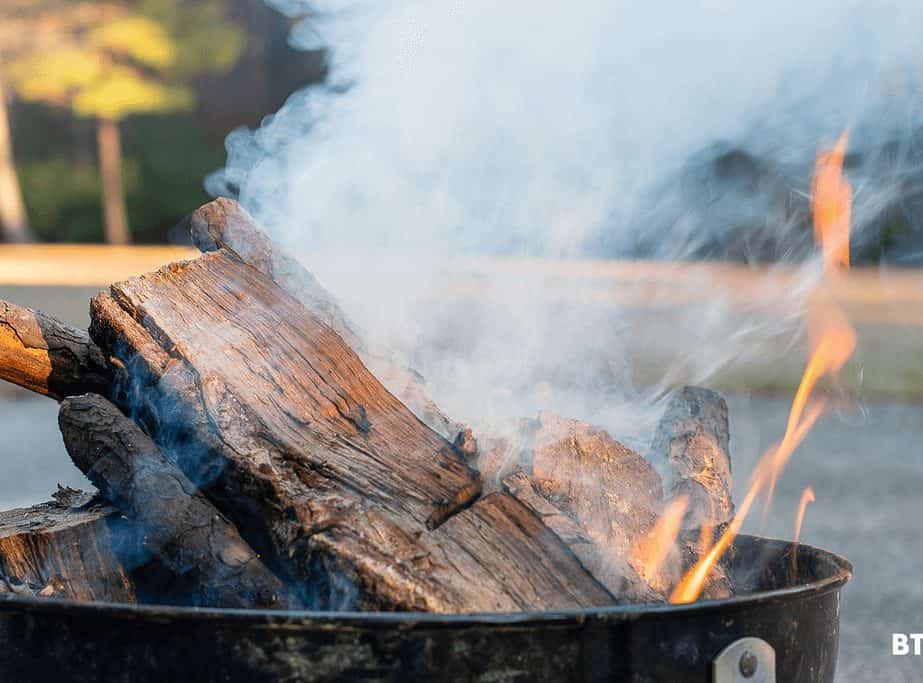
Firewood dried/seasoned over time will naturally have a lighter feel when handled, have a more hollow sound when contact is made, no noticeable smell, and a bit of a gray tint depending on the seasoning conditions.
Wood moisture levels can be tracked with an inexpensive handheld moisture meter which can be picked up at your local hardware store.
30% moisture is the minimally acceptable number in my book, but 20% or less is ideal and you should find that’s at least the standard with most kiln-dried firewood available in your area.
If you really want to reduce fire pit smoke effectively, using the right firewood at the right moisture level is going to give you the most bang for your buck.
More on kiln-dried firewood later on in the article.
Other Causes of Excess Fire Pit Smoke
In addition to moisture, there are a variety of other drivers that could be the culprit if you are having regular trouble with fire pit smoke.
Some of the following, combined with high moisture, could already be making your recent fire pit burns a smoky mess.
Take a good look at what firewood you’ve been using, or plan to use, to see if it shares anything in common with what we are about to cover.
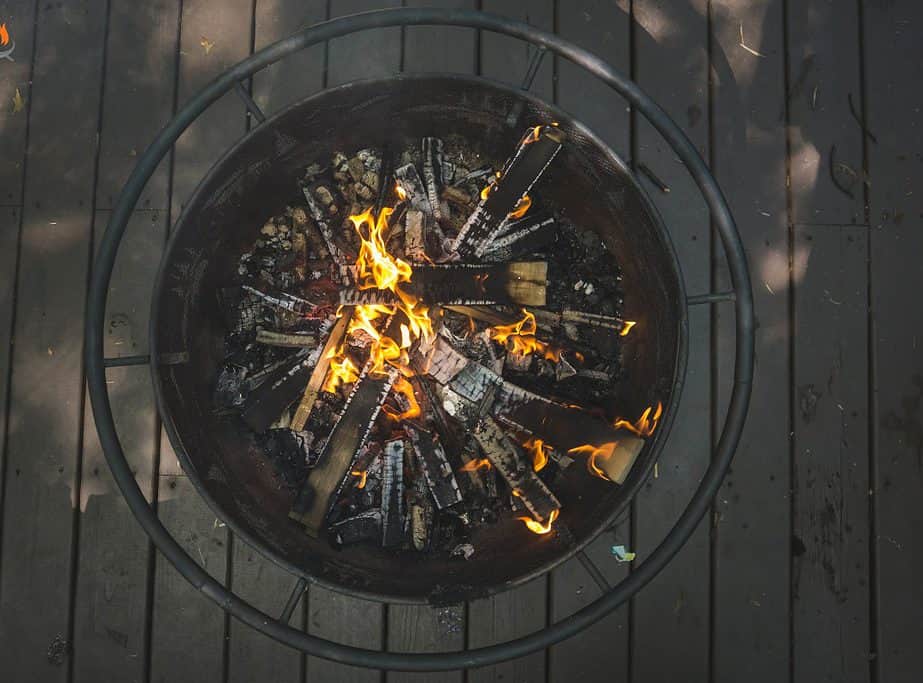
Debris Buildup In Your Fire Pit.
Old and potentially damp ash, embers, and other debris that has accumulated in your fire pits from recent burns could slow the ignition of your current fire, resulting in a fire pit they not only won’t catch but will smoke a lot as you stumble around trying to figure out what to do.
Firewood with High Pitch (Sap) Content.
Growing up in a rural, heavily-wooded area in Southern New Jersey (Cape May County) I remember there was always a standing “rule” against burning pine.
The more I’ve learned though, the more I’ve discovered softwoods like pine can be useful in the initial stages of a fire, especially when trying to get the main fuel source to burn, preferably a hardwood of some type.
I think the concerns I learned as a kid were most likely connected to fireplace use and even there I’m not sure that concern is warranted entirely.
The belief was that pine and other softwoods gummed up your chimney quicker than other types of wood.
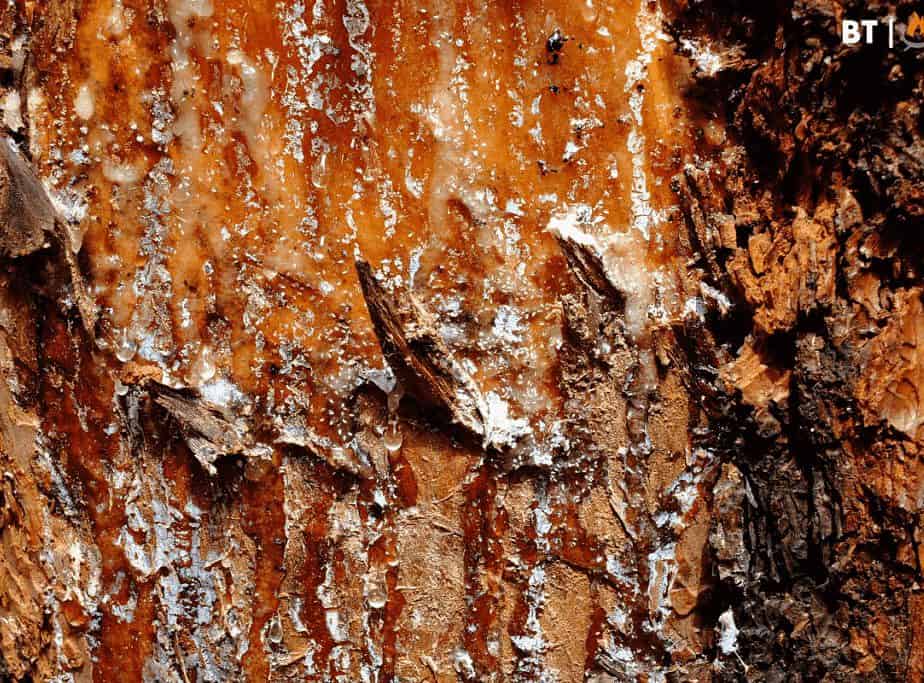
It sounds logical considering the high sap content of these types of wood, but I’m not entirely convinced.
Anyway, softwoods like pine, juniper, balsam, spruce, etc. can burn very hot for short periods of time, making them good firestarter wood.
With that said, these wood types with pitch that has been exposed to air and hardened can smoke quite a bit when burned.
In fact, “fatwood” from the heartwood of pine trees, has been used for hundreds of years as a firestarter wood.
The terpene in hardened tree sap, which is in high concentration in fatwood, ignites quickly, helping the rest of the fire get started.
You can find fatwood at your local hardware store, from your firewood supplier, and from a handful of online vendors.
If you are interested in finding your own fatwood out in nature, this is a very good tutorial on how to do it at Instructables.
What is terpene? Terpene is the naturally occurring flammable chemical in tree sap that makes pines and other softwood wood types excellent firestarter wood.
Bottom line, split softwoods aren’t always the best choice for your main firewood source. They can smoke excessively plus, they don’t burn for a long time.
Well-seasoned softwoods can work if your options are few but understand the limitations.
Improper Stacking of Firewood in Fire Pit.
A key component to building a quick-starting long-burning fire is good airflow.
Just throwing a few logs into the fire pit with some kindling may not get it done, leaving you with smoldering fire pit fuel instead of a raging fire.
A teepee or log cabin firewood stack will keep air flowing and provide housing of sorts for your tinder and kindling – see the example below.

Take some time to do this right because all you will have is smoke and no fire. See the images below for an example.
Burning of Green Pine Needles, Pine Cones, Tree Bark, Etc.
Sometimes it makes sense to collect debris from the forest floor to use as kindling, tinder, etc. By debris, I mean pine needles, pine cones, tree bark, etc.
If you do use items like these to get your fire started, make sure whatever you collect has no green on it, and everything is good and dry. This kind of debris will smoke like crazy if it hasn’t had a chance to dry out.

Household Waste.
Certain types of treated cardboard will smoke heavily when burned in a fire. Not only will you have to deal with the smoke, but you may also get a sampling of certain fumes that may not be healthy for you and yours.
Stick to tinder, kindling, and firewood in the fire pit. A little newspaper at the beginning of the fire to get things going is ok.
Don’t stuff a week’s worth of papers on a fire that just won’t start to help it along. It’s probably something else keeping it from catching.
5 Ways to Reduce Fire Pit Smoke
There may be other causes of fire pit-related smoke that I didn’t cover, but what we’ve covered so far represents the bulk of what drives excessive smoke in most situations.
Now we can get into a little more detail on how to use this information to keep fire pit smoke to a minimum next time you have a fire.
The following are action steps and other pointers you can use that address a number of smoke-reducing workarounds that can be used in combination with each other or on their own:
1. Use Well Seasoned or Kiln-Dried Firewood
As we covered above, wet wood is bad when trying to keep fire pit smoke down. Using adequately dried wood will produce much less smoke and perform much better for a longer time.
Seasoned (Air-Dried) Firewood for Fire Pits.
As I mentioned before, if you are chopping and stacking your own firewood, I recommend going with hardwoods, vice softwoods, as they tend to smoke less.
Hardwoods do tend to take much longer (6 months to 2 years) to season to a moisture content of 30% or less, but when done correctly they will burn much longer and hotter than any softwood ever would.
When prepping your own woodpile, understand what wood you are working with and how long it’s going to take to season after being freshly chopped.
Each type of hardwood has its own estimated seasoning timeframe so know these times when planning. Naturally, the seasoning time will be reduced if you season your wood indoors in a garage or shed.
Most firewood drying time estimates you will see are for outdoor seasoning specifically.
Oak, which has an average moisture content on the high end among commonly used firewood types (maple, hickory, ash, beech, apple, etc.), and can take anywhere from six months to 2 years to get to the right moisture content for low-smoke burning.
If you recall, I mentioned using a moisture meter to monitor and keep track of your firewood’s seasoning progress. Remember, under 30% moisture is ok, below 20% is what you are shooting for.
If you buy your firewood from a firewood dealer, be sure to ask what type of wood you are getting and the moisture content of the wood.
Have that moisture meter handy when they show up with the delivery to make sure they are providing what they said they would.
You are going to pay the same whether it’s adequately seasoned or not. Make sure it is to get the best lighting and heat performance for your money.
Kiln-Dried Firewood for Fire Pits.
Kiln-dried firewood is still somewhat of a luxury and you’ll likely pay around a 30% premium over conventional air-dried firewood delivery.
The upside is that it is very dry wood, having sat in a special firewood kiln for two days at ~250°F to reach that optimal goal of 20% moisture or less.
Kiln-dried firewood is ready to burn immediately and because the moisture content is so low, smoke is minimal to non-existent.
It should light easily, stay lit, and burn hot and long, especially in comparison to non-kiln-dried firewood.
Another very nice benefit of kiln-dried firewood, not related to fire pit smoke specifically, is the elimination of insects and mold from the wood due to the high-heat production process.
This feature makes storing some of your firewood inside the house a much easier choice.
If you are buying kiln-dried firewood just for your fire pit, order what you think you’ll use in the near term. As I said, it’s expensive and unless you have room for indoor wood storage, the benefits could be offset by exposure to damp conditions outdoors.
For more on the subject of kiln-dried firewood for fire pit use, check out my article on the topic here or this factsheet from the U.S. Department of Agriculture’s Forest Products Lab on kiln drying times for oak firewood.
Bottom Line: Make sure you are using dry (to very dry) firewood, preferably hardwoods, to reduce fire pit smoke. Once you’ve tried kiln-dried firewood though it’s hard to go back to anything else. Check out Cutting Edge Firewood, a premium firewood delivery service near Atlanta, Georgia, to learn more.
2. Focus on Using Firewood Types That Naturally Smoke Less
We’ve talked about how hardwoods don’t smoke as much as softwoods and how they perform better in your fire pit, but not all hardwoods are low smoking.
We’ll talk about them and hit the softwoods one more time in an effort to keep smoke to a minimum.
Hardwoods As Firewood.
Because of their natural density, hardwoods tend to hold much less water than other types of wood and we know water is not our friend with regard to the subject at hand. Looking at you softwoods!
Oak, ash, hickory, and maple are good examples of low-smoking hardwoods.
Hardwoods that tend to smoke more than others include eucalyptus, poplar, elm, and others (see below).
These examples all perform well from a heat and longevity standpoint but are known to smoke, so consider excluding them if minimizing smoke is your goal.
Softwoods As Firewood.
Although softwoods like pine, spruce, cedar, hemlock, fir, etc. might be plentiful in your area and you may be tempted to go with that as a choice for your fire pit, they do, as covered before, have a reputation for producing more smoke than other types of wood when burned.
To recap from before, the dried pitch, or sap, from these types of wood can smoke heavily in a fire pit fire.
If you must or insist on using softwoods in your fire pit, make sure they are well-seasoned, and I mean well-seasoned, dry as a bone.
Even when thoroughly seasoned, expect smoke from softwoods, maybe just a little less of it.
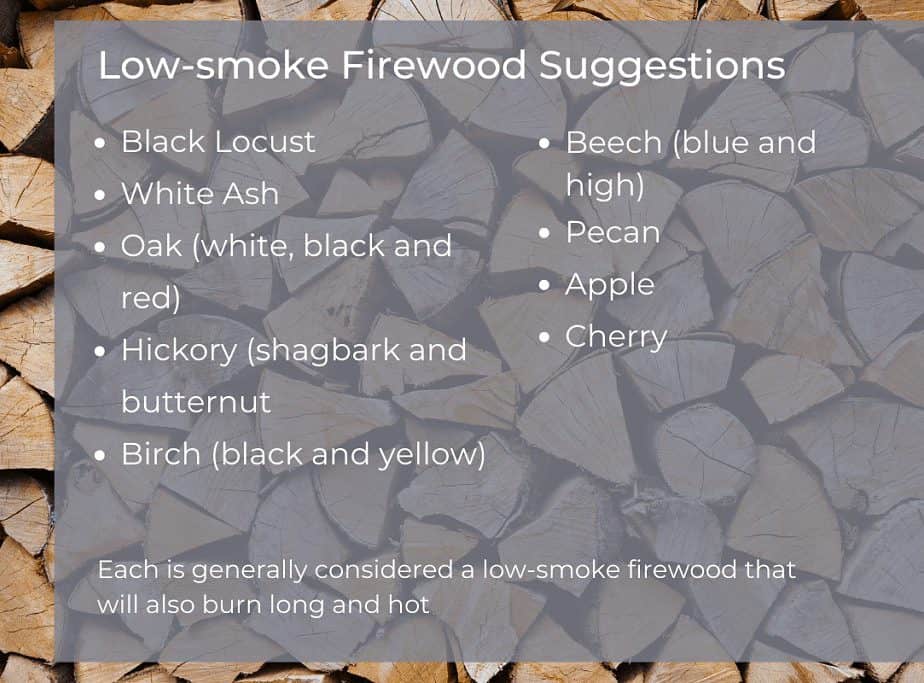
3. Take the Time to Build a Fire That Starts Quickly and Burns Long
The way you stack your firewood in your fire pit is going to have a direct impact on how quickly the main fuel sources ignite and really start to burn efficiently.
That efficiency is a key contributor to keeping smoke from forming and burning it off quickly if it does.
Good airflow between the pieces of firewood is the key difference between a fire that lights quickly and one that smolders and smokes.
I’m partial to the log-cabin configuration as it’s more stable and less likely to collapse and throw hot debris from the fire pit, see below.
Tinder and kindling can be loosely packed in the center at the base for quick and easy ignition.
How to do it:
Split firewood is stacked with two pieces parallel to each other, with roughly 12″ or more between them, depending on the room you have in your fire pit.
You then create another row on top of the others with similar spacing, each laying across the ends of the pieces on the first row.
Repeat the process until you have 3-4 levels – the number of levels will also depend on the amount of room you have in your fire pit.
Likewise, a tipi stack is another option mentioned prior that is relatively stable and allows for strong airflow between firewood.
How to do it: As the name infers, firewood pieces are stacked upward against each other in a circular cone-like stack, evenly distributed for good airflow, while maintaining a wide base.
Tinder and kindling are then loosely packed at the base, inside the tipi – also see below.
Check out my article How to Start a Fire Pit for more on the subject.
4. Keep Your Fire Pit Clean After Every Use to Reduce Fire Pit Smoke
Old fire pit debris (ash, embers, partially burned firewood, etc.) from prior burns may become damp if left out in the elements.
Building a new fire on top of this debris may inhibit your ability to get a good fire started.
Take a moment to clear your fire pit of all debris after it has completely cooled.
If you are able, cover the fire pit, turn it on its side or completely over, or store it indoors to keep water from collecting (and rust from forming).
Taking these steps will save you from having to clean the sloppy mess of fire pit ash and water out of your fire pit before your next burn and help you get a strong, smoke-free fire started from the word go.
5. Consider Using a Smokeless Fire Pit to Drastically Reduce Fire Pit Smoke
Fire pits have evolved quite a bit in the last few years, going from simple metal bowls or masonry fire pits with a fire ring to a new take on old technology.
What’s the old technology? It’s called a top-lit updraft gasifier or TLUD. A couple of innovators in the outdoors and backyard fire space have used this design to build fire pits that burn very efficiently, reducing smoke to minimal or non-existent levels.
In a nutshell, these firepits are built with a double wall structure that utilizes a unique air circulation system designed to both feed the fire and burn off excess smoke before it escapes.
The great thing is that these fire pits have been able to deliver on the smokeless claim.
Understand though, smokeless doesn’t mean “no smoke,” just greatly reduced smoke.
You may get a little at the moment when new firewood is added but it usually passes quickly.
Smokeless Fire Pits: The Current Market
Currently, there are four primary players (in my opinion) in the
All four companies use TLUD in their design and have been pretty successful in carrying the technology over from the industrial market to the recreational side.
Just a few facts about each company and their product lines…
Solo Stove.
- The company formed in 2010, building cooking stoves for campers – currently headquartered in Southlake, Texas, a suburb of Dallas/Fort Worth <— link to Google Maps
- Sought to expand into fire pits in 2016 (their main business was camp stoves prior), working with Kickstarter to raise funds for the venture
- Solo Stove currently offers three fire pit choices to consumers, the Ranger, Bonfire, and Yukon, listed from smallest to largest. <— All links are to solostove.com.
For more on
Breeo.
- The company was formed in 2011 in Lancaster, Pennsylvania. Technically, the company is in Kinzers, just down the road about 15 miles
- Built their first
smokeless fire pit in 2011
- Breeo currently offers three smokeless fire pit options: the Y Series portable smokeless fire pit (21″ diameter), the popular X Series line, in 19″, 24″, and 30″ diameters, and its high-end Luxeve model (33″ diameter). <— all links to Breeo
Tiki.
- The company, currently headquartered in Menomonee, Minnesota, was formed in the early 1960s and quickly became known for their iconic Tiki torches
- Built their first smokeless fire pit in 2020
- Tiki Brand currently offers two smokeless fire pit options, its Patio Fire Pit (27.5″ diameter) and its Portable Fire Pit (14.5″ in width) <— links to Tiki
Flame Genie.
- The company was formed in 1947 in St Louis, Missouri, and builds a variety of products related to residential heat generation and ventilation
- Currently offers one fire pit design in four size/finish configurations; the Flame Genie Inferno in stainless or black powder coat; 13.5″ or 19″) <— link to Amazon
- Flame Genie fire pits are fueled with wood pellets as opposed to regular firewood <—link to Amazon
All fire pits mentioned are considered smokeless by their manufacturers.
As I mentioned before, a smoke-free fire pit doesn’t exist, however, these fire pits will dramatically cut down the amount of smoke you might experience with your typical non-smokeless fire pit.
Also, smokeless fire pits are a little more forgiving when it comes to the moisture content of wood due to the efficiency of the burn.
Once you get the fire going, less dry wood can be added later and these fire pits do a surprisingly good job keeping the smoke down and burning through the wood.
Finally,
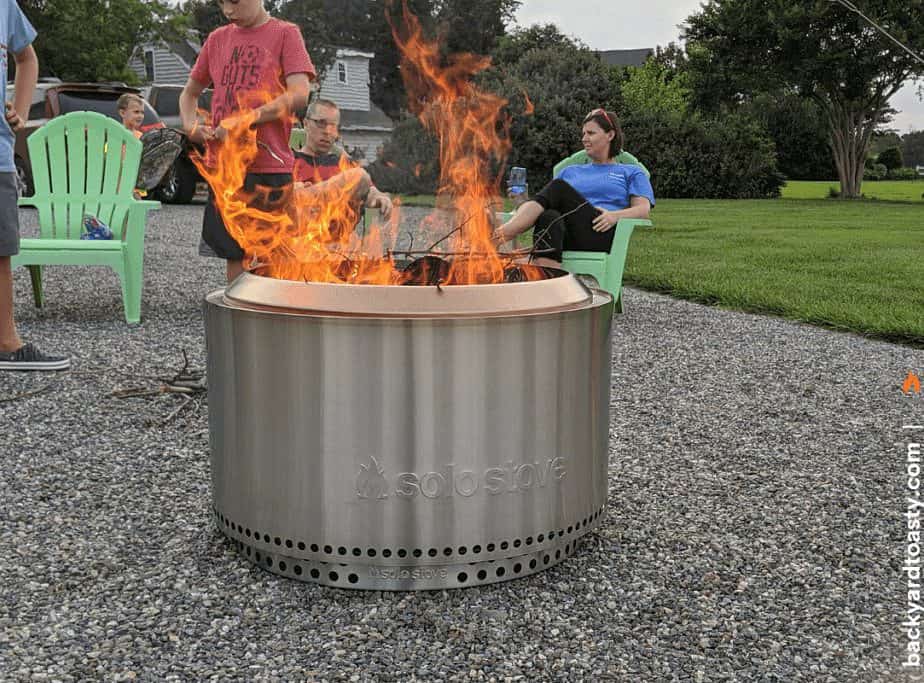
Conclusion
There’s really not a lot to reducing fire pit smoke. Using well-seasoned dry firewood is going to do the most to move the needle in the right direction.
If you have a lot of firewood choices, go for those typical hardwood kinds that are known not to smoke excessively for a little extra peace of mind.
Take your time building your fire, making sure to give the fuel space to breathe to prevent smoldering and smoking.
Keep your fire pit clean, dry, and ready to use the next time you decide to fire it up. You’ll get better performing, low-smoking fires, plus your fire pit will not only look better when you aren’t using it, but it will also last much longer.
If you’ve done everything on this list to reduce fire pit smoke and still aren’t satisfied, go all the way and try a
Fortunately, there are a lot of quality options on the market that work as advertised, look good, and won’t break the bank.
Take your time and shop around to find one that meets your size and performance needs. I don’t think you’ll be disappointed.
Good luck in your battle to reduce fire pit smoke and thanks for reading!
Related Questions
How much does an average firewood moisture meter cost?
You don’t have to spend a lot of money on a wood moisture meter to get accurate and reliable moisture readings.
Options at your local big box hardware store or online should be in the range of between $25 and $100.
The sweet spot in this range is around $35, which should give you a well-built moisture meter you can depend on at a reasonable price. Don’t go much higher than that number.
What are wood pellets?
Wood pellets, like the ones mentioned above for the Flame Genie, are essentially small pieces of processed hardwood formed into a cylindrical shape about the width of a pencil and measuring about a half in. to 3/4 in. long.
By design, they typically have a moisture content of under 10%, which is great for keeping fire pit smoke at a minimum. They are typically scooped into the base of the fire pit and started with help from a flammable wood pellet gel.
While these fire pits do burn very cleanly and don’t leave a lot of residues behind, I personally don’t like the fact that you can only fuel your fire pit with this one type of product.
Plus there are a limited number of suppliers that make wood pellets, and it’s not as easy as firewood to get your hands on when you need it.
Besides fatwood, what other firestarter is good at getting a fire going?
A good homemade fire starter can be made by stuffing dryer lint into a toilet paper roll. Easy, cheap, and effective. You throw these things out anyway, why not save them and use them to get your fire pit started?
There are also a wide variety of relatively inexpensive store-bought fire-starting aids like x or x, which are very effective in getting fire pit fires started quickly.
Is using lighter fluid to start a fire pit a good idea?
No, it’s not a particularly good idea. From a safety standpoint, you can quickly turn your would-be small fire pit fire into a raging inferno that could injure someone or worse and cause property damage.
Secondly, lighter fluid is a crutch for not building a fire that can breathe, light easily, and stay lit. Also, using lighter fluid is no guarantee that your fire will stay burning after the lighter fluid has burned off.
What is the closest thing to a smoke-free fire pit currently available?
On the wood-burning side, the smokeless fire pits I mentioned in the article are the closest thing you’re going to get to smoke-free.
A propane or natural gas fire pit is the closest you’ll get to smoke-free among all fire pits. If your gas fire pit is kept clean and well-maintained you should experience almost no smoke coming from it.
Smoke from these types of fire pits can often be an indicator of an equipment problem.

